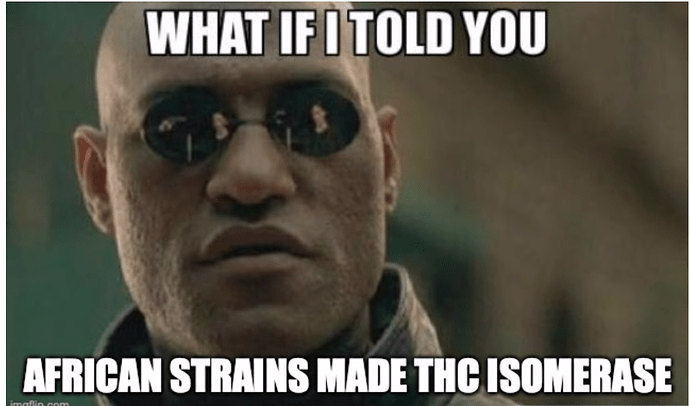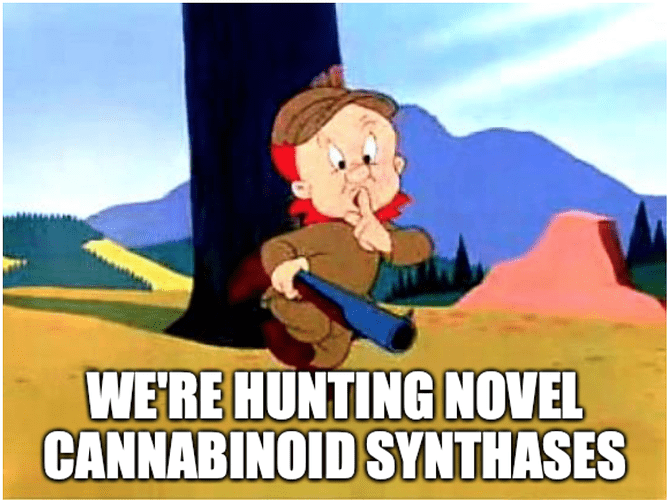Yes, I consider CBN to be naturally occuring.
Do you make a distinction between naturally occuring cannabinoids and naturally occuring isomers/degradation products, or are they both more or less the same to you?
For me they are entirely different. I can encourage increased percentages of naturally occuring cannabinoids with most breeding practices (both traditional and modern), but breeding practices will not encourage increased values of naturally occuring isomers. It is for this reason that I find a strong difference between the two and also why I believe they need separate definitions.
To me, if it didn’t require humans deliberately producing it, then it’s natural. And it is a cannabinoid. So it’s a naturally occurring cannabinoid (unless, of course, it was made by humans using deliberate techniques).
I would say, if you want to make a distinction, it would be “biosynthetized cannabinoids” vs “naturally converted” (or whatever you’d like to call it). But one is not more natural than the other, they both occur in nature.
That said I am not ruling out that D8 may be biosynthesized in some quantity. Saying “there aren’t any strains with it as a major constituent” is a weak argument – there’s like 100 other minor cannabinoids known to be biosynthesized and no strains have been found with them as a major constituent either.
I never suggested that one was more natural than the other, which is why I labeled them as:
I would also venture to state that once a cannabinoid has hype and buzz around it, people begin breeding for it. D8, being the hottest novel cannabinoid on the market (pun intended) would have encouraged breeding for it if it was being biosynthesized.
I’m not suggesting either one of us is right or wrong; I’m merely attempting to help us find consensus through discourse and dialogue.
Thanks for keeping the conversation going and responding to my statements/questions.
I am pretty convinced it exist in nature
West and southafrikan strains are richer with it than the rest
…but the isomers ARE cannabinoids, so making the distinction between cannabinoids (natural or otherwise) and isomers/degradation products (some of which, eg CBN are cannabinoids) doesn’t make any sense to me. (not that that is a requirement ![]() )
)
yep, if it can be done with a push and a shove in a flask, it can be done with a nudge from an enzyme…
So then there should be no distinction or refined labeling between types and flavors of cannabinoids? For me, that’s like saying there shouldn’t be a distinction between cocaine and coca leaf or opium (poppy sap) and heroin/morphine.
The language we use matters, and we are working towards refining (and defining) language with cannabis. I’ve known you for a long time, and I know for a fact you prefer specific, refined use of language. Why does this not matter?
The difference between being able to breed a plant to produce a compound vs needing to convert a compound after it has been produced is a pretty big difference for me. May not be for others, but I personally care about how this is defined.
CBD and Delta 9 are isomers.
the plant produces them individually, and (probably) doesn’t interconvert them (much).
(see in vitro synthase activity to investigate the rational for those caveats)
So you’re not really looking to distinguish isomers from natural cannabinoids. you’re looking to distinguish cannabinoids that were isomerized by some schmuck you don’t trust after the plant produced them.
I’d argue that just naming the cannabinoid is plenty.
seems like it’s synthetic vs natural, that you’re looking for on the appellation.
Isn’t that question the foundation of this conversation? Unless someone decides to modify it, the thread’s title is “D8 naturally occuring in plant?”…
it might even fall out of a homology search as a THC synthase…if you had the sequence, and it existed. or you could try building one using a synthase as your starting point.
I would say this conversation is evidence that folks are thinking about that phenotype hunt, but it’s way easier to buy CBD at rock bottom prices and dump random acids in the flask than it is to organize the analytics and genetics behind a decent novel cannabinoid screening project.
So I don’t by the argument that “we should have seen it by now”.
besides, it’s major claim to fame is “legal in all 50 states. gets you high.” which I guess would still work if you if you managed to knock out the last little bit of D9 in your hemp too, but isn’t quite the same motivation as “chad will pay $20k a kilo for this shit”.
I do respect the various “I see some” and @Roguelab’s “I see more”, and would absolutely love to know how the D8 folks are seeing is actually being produced in planta.
my first guess would not be an isomerase, but that does seem like one way to break a synthase with a mutation or 6.
It is present in all cbd (and mixed) flowers, usually at a ratio 1:100 regarding cbd.
Being found in trace amounts in flower testing holds about as much weight in this argument (for me) as my argument does for you. Correlation does not equal causation (for both of our arguments).
Also, this is not an argument of “can we make this happen” … we are debating whether this is already happening.
CBC? usually shows in “trace amounts” only. until it didn’t.
synthase looks a lot like a THC synthase.
to me the homology between CBD/THC/CBC synthases suggests the real possibility of a d8 heavy variant. [queue mulder meme: it’s out there…]
yes I can certainly come up with other explanations for high D8 numbers in southern/western African cannabis.
I’d prefer to blame the genetics, even if it’s only about the trichome pH (which could easily be the soil…)
And this is why it is important to surround yourself with people smarter than yourself (or who at least provide strengths in areas one may be lacking).
Still not convinced, but we’re getting closer. Haha
CBC is interesting as well.
It is usually an “important” one with CBG in juvenile plants.
Then it turn into a minor one.
In CBD plants, it is always in certain proportions, usually 1:1 regarding D9, but get up to 5:1 in certain outdoor strains. I have not seen CBC dominant strain yet.
I don’t believe that delta 8 can be an artifact from sample preparation.
It is always seen in the CBD plants, but never in the THC ones.
If it was an isomerizetion product, there should be much more showing in D9 rich samples…
Looking at my data in more details (flowers, crude extracts, hash) the ratio to CBD is rather usually 1:80 to 1:90. A pretty stable number compared to CBC.
I believe it comes from plant metabolism.
my bad. with a knock-out, I apparently still add an over-expresser as “a natural part of the toolbox”.
although the language still works ![]()
I know Adam Jacques down in Eugene is working on CBC and THCv cultivars. He’s got some impressive hemp autoflower lines going too

